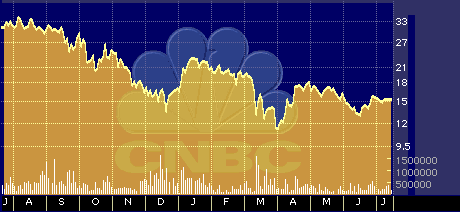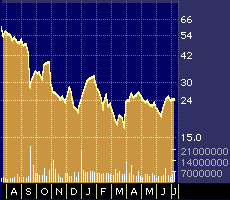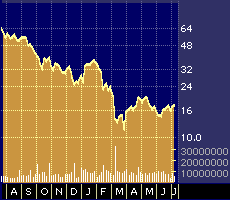
Nextel Partners IPO Makes Solid Debut
Nextel Partners IPO Makes Solid Debut
by Hal Plotkin
Silicon Valley Correspondent
Analysts say Nextel Partners Inc.’s {NXTP} success in wooing rural users of wireless-communications services should push the company’s stock to solid long-term gains after its initial public offering got a solid start on Wednesday afternoon.

Nextel Partners Post-IPO Stock-Performance Chart
“I think it looks pretty good,” says Tole Hart, senior analyst at Dataquest, based in New York. “Nextel has a really good name in the market, and Sprint PCS’ s{PCS} stock tripled in the last year. There’s no reason why Nextel’s approach wouldn’t also work in the rural areas,” targeted by Nextel Partners.
Late Tuesday, Nextel Partners priced its 23.5 million shares at 20 a share, at the top of its revised pricing range of 18 to 20 a share. Shares were originally to be at 16 to 18 a share.
Kirkland, Wash.-based Nextel Partners is the only U.S. affiliate of Reston, Va.-based Nextel Communications Inc. {NXTL}, which owns 36.5 percent of the firm. Nextel Partners extends Nextel Communications’ service area to the more than a dozen small and mid-size markets in the United States, including communities in Hawaii, New York, Pennsylvania and Texas.

Sprint PCS 52-Week
Stock-Performance Chart

Nextel Communications 52-Week Stock-Performance Chart
“Overall, I feel pretty optimistic about Nextel Partner’s stock price,” says Honjun Li, director of research at Parks Associates, based in Dallas. “Investors will have to do some basic research, but once they understand Nextel it will be relatively easy to understand the advantages of their business model.”
Analysts say Nextel Partners and its parent firm have had more success than other wireless operators attracting lucrative business customers. Business users typically spend more per month, on average, than residential users of wireless telecommunications services.
Nextel has been winning those customers thanks in large measure to a unique set of features that are designed to appeal to heavy users of wireless services.
Nextel’s handsets, for example, double as two-way radios, a “push-to-talk” feature that has proven very popular with taxi-cab fleets, delivery services, and other large groups of mobile workers.
Nextel customers can access the “push-to-talk” feature to connect with other Nextel handsets in their local service area without additional charges beyond regular monthly fees. About half of all traffic on the Nextel network comes from customers taking advantage of that service.
“It’s been a very good way for them to attract business customers,” says Li, of Parks Associates. “They’re probably the strongest competitor in the wireless market for business customers, which is good, because they get more revenues from those subscribers.”
Li notes that Nextel currently generates higher average revenues per subscriber, about $70 a month, as compared with the industry average of about $40.
Some analysts, however, worry that the success of Nextel and its subsidiary could paint both companies into a corner of the market that is not expected to be the fastest-growing segment moving forward.
There are projected to be an estimated 99 million residential or consumer users of wireless services by 2004, as compared with just 44 million business users, according to a recent estimate by International Data Corporation, based in New York.
“Of all the segments they could choose they’ve chosen the one that is growing the least,” says Iain Gillott, vice president of worldwide consumer and business telecommunications at IDC, based in Austin, Texas. “That could be a problem for them.”
Gillott says it’s quite likely, even inevitable, that other leading wireless firms such as AT&T {T}, Sprint {FON}, and SBC Communications {SBC}, will all soon train their sights on more effectively serving business customers, including offering features similar to the “push-to-talk” capabilities that gave Nextel an early advantage in the market.
“Nextel has unique features for now,” Gillott says. “But there are already other [handsets] being made that do the same thing. The other carriers are going to want a piece of that action. And they are going to get it.”
One way they might get it, Gillott says, is by acquiring Nextel and or Nextel partners down the road if, as expected, the Federal Communications Commission eventually relaxes current restrictions on how much spectrum any one wireless firm can own.
“This is a tough one to predict,” he says. “On balance, though, I don’t see Nextel surviving as an independent company. They’ve already signaled to the market that they’re willing to be swallowed up for the right price.”
Either way, though, Gillott concedes Nextel Partners would remain an attractive investment.
“What they have is a natural way for some of the other major wireless companies to fill in some of their holes,” he says.
Nextel Partners, Inc., which was founded in 1998, posted a net loss of $59.1 million on revenues of $20.5 million for the nine months ended September 30, 1999 as compared with a net loss of $11.6 million on revenues of $2.1 million for the same period one-year earlier.
Motorola, Inc., which manufactures the handsets used by the firm, owns a 6.1 percent stake in the company.


